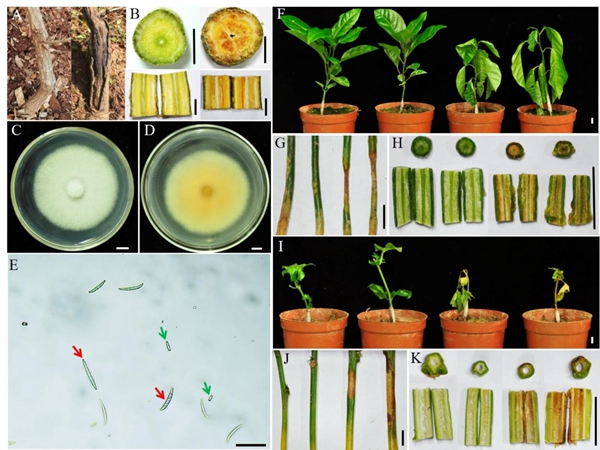Purple passion fruit (Passiflora edulis Sims) is a perennial climbing vine and is grown worldwide as an edible tropical fruit with excellent nutritional value and high economic value. With the increasing expansion of the plantation area in China, considerable economic loss caused by collar rot has attracted wide attention.
From 2018-2020, collar rot resulted in the death of many plants of P. edulis 'Mantianxing', a commercial cultivar in China, in southwest China's Yunnan province. The disease spread quickly, and field incidence reached more than 50%. Stem rot symptoms were observed at the base of the stem, about 5-10 cm from the ground, resulting in wilting, defoliation, and death of plants.
Researchers from Xishuangbanna Tropical Botanical Garden (XTBG) collected representative symptomatic samples from the base of five plants and isolated the fungal colonies. They sequenced amplicons from all six isolates and obtained identical sequences.
Based on a multilocus phylogenetic analysis of the ITS1, EF-1 and RPB2 sequences, coupled with the morphological characteristics, the isolate (designated as NsPed1) was considered to be Neocosmospora solani (syn: Fusarium solani).
Finally, N. solani NsPed1 was identified as the causal pathogen of collar rot in P. edulis 'Mantianxing'.
This is the first report of collar rot in purple passion fruit (Passiflora edulis) causes by Neocosmospora solani in Yunnan province, China. The study was published in Plant Disease.
Contact
WU Fuchuan
Department of Gardening and Horticulture, Xishuangbanna Tropical Botanical Garden, Chinese Academy of Sciences, Menglun, Mengla, Yunnan 666303, China
E-mail: wfc@xtbg.org.cn

The symptoms of collar rot in purple passion fruit (P. edulis 'Mantianxing') and
morphological characters of Neocosmospora solani isolate NsPed1.

Purple passion fruit (P. edulis 'Mantianxing')


